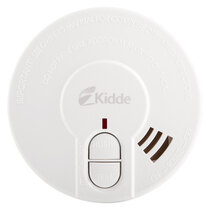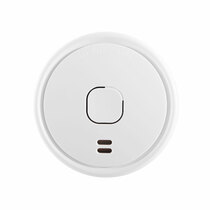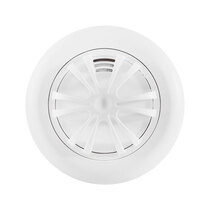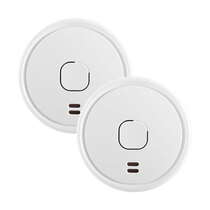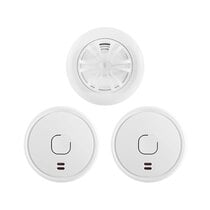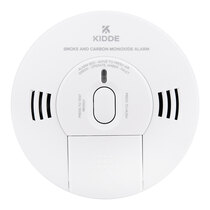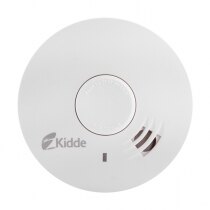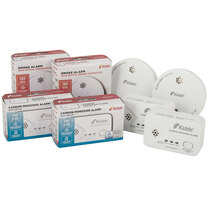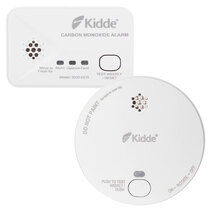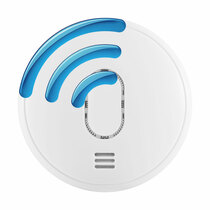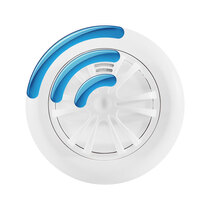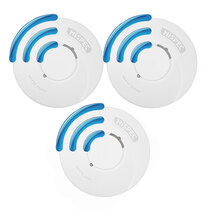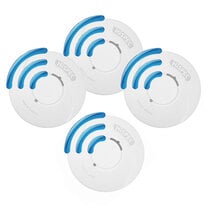-
Contact
Sales & Customer Service
0800 612 6537 support@safelincs.co.uk Live ChatDelivery Enquiries
0800 077 6149 - Resources
Fire & Safety Solutions
CALL OUR TEAM NOW 0800 612 6537
Lines open today 8am - 6pm
FREE Delivery
on marked products
Live Chat - Online
Instant help & Advice
Trade Discounts
and exclusive pricing
0% Credit Available
Open an account now
5 Star Customer Feedback
All Smoke Alarms
Explore our comprehensive range of smoke alarms and heat alarms, designed to suit the needs for your home. Whether you're looking for mains-powered smoke alarms for long-term reliability, battery smoke alarms for easy installation, or interlinked smoke alarms for enhanced safety, we've got you covered. Our selection also includes smoke detectors and heat alarms to ensure full protection against fire risks in various environments. Stay safe and compliant with our top-quality smoke alarms, trusted by homeowners and professionals.
Battery Optical Smoke Alarm - Kidde 29HD
- Battery: 9V alkaline battery (included)
- Warranty: 5 year warranty
- Features test and hush buttons
- Sleek and compact design
- Suitable for BS 5839-6: 2019 Grade F2 installations
- Certified to BS EN 14604: 2005
Battery Optical Smoke Alarm - UltraFire UBS1
- Battery: 9V alkaline battery (included)
- Warranty: 10 year warranty
- Large test and hush button
- High performance optical sensor
- Suitable for BS 5839-6: 2019 Grade F2 installations
- Certified to BS EN 14604: 2005
Battery Heat Alarm - UltraFire UBH1
- FREE delivery
- Battery: AA alkaline batteries (included)
- Warranty: 10 year warranty
- Large test and hush button
- Suitable for BS 5839-6: 2019 Grade F2 installations
- Kitemarked to BS 5446-2: 2003
Battery Optical Smoke Alarm - UltraFire UBS1 Twin Pack
- Battery: 9V alkaline battery (included)
- Warranty: 10 year warranty
- Large test and hush button
- High performance optical sensor
- 2 x optical smoke alarms included
- Suitable for BS 5839-6: 2019 Grade F2 installations
- Certified to BS EN 14604: 2005
Battery Smoke Alarms and Heat Alarm Home Essentials Kit - UltraFire UFUB1KIT
- FREE delivery
- Battery: Alkaline batteries (included)
- Warranty: 10 year warranty
- Large test and hush button
- 2 x optical smoke alarms and 1 x heat alarm included
- Suitable for BS 5839-6: 2019 Grade F2 installations
- CE marked
10 Year Longlife Battery Optical Smoke Alarm - Hispec HSABP10
The Hispec 10 year lithium battery operated smoke alarm, has enhanced sensing technology providing continuous protection to detect smoke and give the earliest warning of a potential fire, while minimising false alarms.
- Battery: 10 year sealed lithium battery
- Warranty: 5 year manufacturer's warranty
- Optical smoke sensor suitable for hallways, landings, living rooms, and bedrooms
Combination Carbon Monoxide and Smoke Alarm 10 Yr Warranty - Kidde K10SCO
- Product Life: 10 years
- Battery: 2 x AA alkaline battery powered (included)
- Warranty: 10 year warranty
- Combined optical smoke and carbon monoxide detector
- Ideal for hallways, bedrooms, and living rooms
- Voice alarm and sounder: different warning messages for smoke and CO
- Certified to BS EN 14604: 2005 (smoke alarm)
- Certified to BS EN 50291-1: 2018 (CO alarm for domestic use)
10 Year Longlife Battery Optical Smoke Alarm - Kidde 10Y29
- FREE delivery
- Battery: Built-in, lasts the lifetime of your alarm - GUARANTEED
- Warranty: 10 year warranty
- Features test and hush buttons
- Low Volume Test feature
- Suitable for BS 5839-6: 2019 (Grade F1 installations)
- Kitemarked to BS EN 14604: 2005
10 Year Longlife Battery Optical Smoke Alarm - UltraFire ULLS10
Powered by a 10 year sealed lithium battery and featuring an optical smoke sensor specially designed to maximise smoke detection and minimise false alarms, this alarm provides top-class standalone protection.
- Battery: 10 year sealed lithium battery
- Warranty: 10 year manufacturer's warranty
- Optical smoke sensor suitable for hallways, landings, living rooms, and bedrooms
10 Year Longlife Battery Heat Alarm - UltraFire ULLH10
Ideal for rooms like garages, kitchens, and lofts where dust or fumes would cause false activations of smoke alarms, the UltraFire ULLH10 features a sealed 10 year battery and 10 year manufacturer's warranty.
- Battery: 10 year sealed lithium battery
- Warranty: 10 year manufacturer's warranty
- Heat sensor suitable for kitchens and garages
Kidde Home Fire Safety Kit - Kidde 2030 Series
- Battery: Replaceable batteries
- Product Life: 10 years
- Warranty: 3 year warranty
- 2 x optical smoke alarm and 2 x CO alarm included
- Combined test / hush button
- Compact and unobtrusive design
Kidde 2030-DSR Optical Smoke Alarm & 2030-DCR Carbon Monoxide Detector Special Offer
- Battery powered optical smoke alarm
- Certified to BS EN 14604: 2005
- Battery powered CO detector
- Kitemarked to BS EN 50291-1: 2018 (domestic use)
Radio-Interlinked Battery Powered Optical Smoke Alarm - UltraFire UBS1RF
- Battery: AA alkaline batteries (included)
- Warranty: 10 year warranty
- Large test and hush button
- Toast-proof sensor
- Wireless interlink up to 50 compatible alarms
- No central control panel needed
- Suitable for BS 5839-6: 2019 Grade F2 installations
- Certified to BS EN 14604: 2005
4.8 out of 5 stars
View Product
| 1 unit |
£22.79 inc VAT £18.99 ex VAT |
|---|---|
| 2+ units |
£21.59 inc VAT £17.99 ex VAT |
Radio-Interlinked Battery Powered Heat Alarm - UltraFire UBH1RF
- Battery: AA alkaline batteries (included)
- Warranty: 10 year warranty
- Large test and hush button
- Wireless interlink up to 50 compatible alarms
- Range of up to 35m in buildings
- Suitable for BS 5839-6: 2019 Grade F2 installations
- Certified to BS 5446-2: 2003
Radio-Interlinked Smoke Alarms and Heat Alarm Home Essentials Kit - UltraFire UFUB1RFKIT
- Battery powered with AA alkaline batteries
- Warranty: 10 year warranty
- Large test & hush button
- Wirelessly interlink up to 50 UltraFire UB1RF series alarms
- 2 x optical smoke alarms and 1 x heat alarm included
- Suitable for BS 5839-6: 2019 Grade F2 installations
10 Year Longlife Battery Combination Optical Smoke and CO Alarm - FireAngel SCB10-R
- Product Lifespan: 10 years
- Battery: Built-in, lasts the life time of your product
- Warranty: 3 year warranty
- Combined optical smoke and carbon monoxide detector
- Ideal for hallways, bedrooms and living areas
- Sleep Easy™ function
- Kitemarked to EN 14604: 2005 (smoke detection)
- Kitemarked to EN 50291-1 (carbon monoxide detection)
- Suitable for ceiling installation
Radio-Interlinked 10 Year Sealed Battery Heat Alarm - UltraFire ULLH10RF
The UltraFire ULLH10RF features a sealed 10 year battery and wireless interlink with up to 15 total alarms to alert the whole house of a possible fire emergency. Ideal for kitchens, garages, basements, and lofts.
- Battery: 10 year sealed lithium battery
- Warranty: 10 year manufacturer's warranty
- Heat sensor suitable for kitchens and garages
- Wireless interlink up to 15 total alarms
Radio-Interlinked Sealed Battery Powered Smoke & Heat Alarms - Hispec RF10-PRO Range
- Battery: 10 year sealed lithium battery
- Warranty: 5 year warranty
- Radio-interlink up to 20 Hispec RF10-PRO Alarms
- Suitable for BS 5839-6: 2019 Grade F1 installations
- Compatible with the Hispec Control Unit and Carbon Monoxide Alarm
- Alarms sold separately
- Compliant with Scottish 2022 and Northern Ireland Landlord 2024 legislation
Radio-Interlinked Sealed Battery 2 Smoke and 1 Heat Alarm Kit - Hispec RF10-PRO Range
- Battery: 10 year sealed lithium battery
- Warranty: 5 year warranty
- Radio-interlink up to 20 Hispec RF10-PRO Alarms
- Suitable for BS 5839-6: 2019 Grade F1 installations
- Compatible with the Hispec Control Unit and Carbon Monoxide Alarm
- Also suitable for the 2022 Scottish legislation
Radio-Interlinked Sealed Battery 3 Smoke Alarms and 1 Heat Alarm Kit - Hispec RF10-PRO Range
- Battery: 10 year sealed lithium battery
- Warranty: 5 year warranty
- Wirelessly interlink up to 20 Hispec RF10-PRO devices
- Suitable for BS 5839-6: 2019 Grade F1 installations
- Compatible with the Hispec Control Unit and Carbon Monoxide Alarm
- Also suitable for the 2022 Scottish legislation
Page 1 (20 of 82 Products)
Mains Powered Smoke Alarms
Mains powered smoke alarms are powered by the electrical circuit of a building and are mainly used in residential new builds, rented accommodation and smaller commercial applications. Mains powered smoke alarms offer long-term reliability and are hardwired into your property’s electrical system. These smoke alarms are ideal for permanent installations in homes and in businesses, where specified in a fire risk assessment require a Grade D system and where there is a continuous power supply available. All of our hard-wired alarms also come with backup batteries (alkaline or lithium) to ensure protection during power outages. Browse our range of mains-powered smoke alarms for trusted solutions that meet safety regulations and provide dependable, 24/7 fire detection.
Radio-interlinked Smoke Alarms
Radio-interlinked smoke detectors have integrated radio frequency (RF) senders and receivers. If one smoke alarm detects a fire, it passes this information to all other alarms within the same group of alarms to raise the alarm in the entire building. This makes radio-interlinked smoke alarms a top choice for comprehensive fire safety across multiple rooms or levels of a property. Some of the RF smoke alarms have sealed long-life batteries as the only power supply, making them an alternative to mains powered smoke detectors. You can guarantee compatibility between alarms by purchasing a bundle from Safelincs. Some of our bundles include heat alarms to give you comprehensive cover all over your building.
Ionisation Smoke Detectors
Ionisation Smoke Alarms detect changes in the electrical charge of particles in the air within their sensor chamber. They were particularly well suited for 'invisible' or fast-flaming fires, such as paper or dry wood fires, which can give off very little smoke despite having an active flame. They were sadly also very sensitive to burnt toast, which is why they should not be installed near kitchens. Historically, ionisation smoke detectors have been recommended for landings and office spaces, but the technology behind optical smoke alarms advanced to the point that they are interchangeable.
Ionisation smoke alarms are being phased out across the entire fire safety industry, from standalone domestic alarms to detectors in the largest commercial panel systems. This is because they use radioactive material in the sensor to detect the presence of smoke particles in the air, making them dangerous to manufacture, awkward and costly to transport, and an environmental hazard if disposed of incorrectly.
Safelincs has stopped selling ionisation smoke alarms, and we would encourage all of our customers to purchase optical smoke alarms instead. Optical smoke alarms are not potentially hazardous like ionisation technology, due to not using radioactive elements.
Heat Alarms
Heat alarms, as the name suggests, measure temperature rather than detect smoke. They are designed to detect rapid temperature rises, which make them ideal for kitchens, garages, and areas where smoke alarms might trigger false alarms. It is important to know that heat alarms only cover small areas in a kitchen or garage so might require several heat detectors for full cover.
Optical Smoke Detectors
Optical smoke detectors, also known as photoelectric smoke alarms, are highly effective at detecting slow-burning, smouldering fires. They are especially useful in living rooms, bedrooms, and hallways where fires may start gradually, and create a huge amount of smoke due to soft furnishings such as furniture and curtains. These alarms respond to larger smoke particles and are less prone to false alarms from cooking fumes (not in kitchens, though). Safelincs recommend optical smoke alarms for hallways, dining rooms, living rooms, bedrooms.
Compare (0)
Reset




















